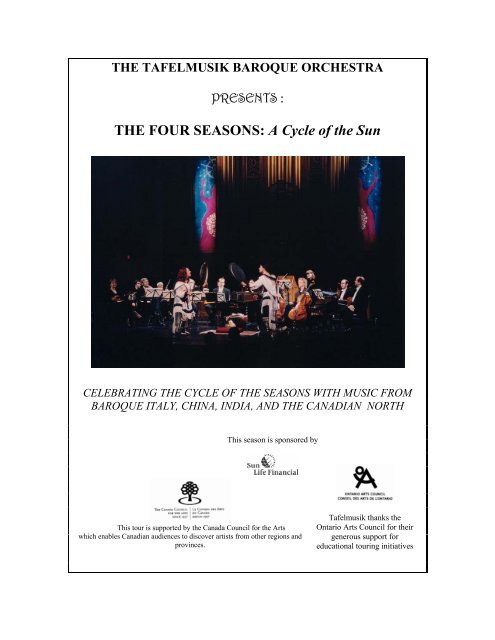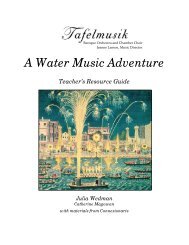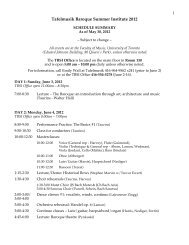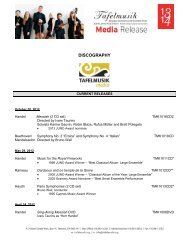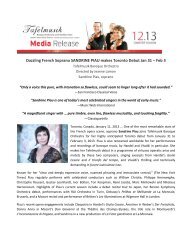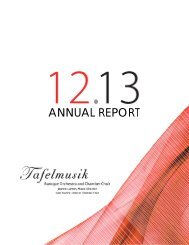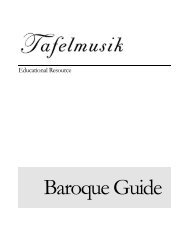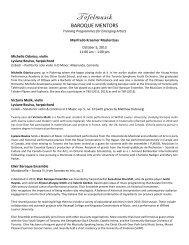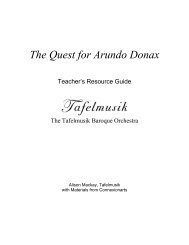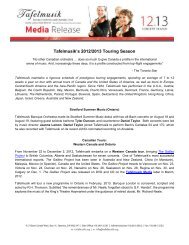THE FOUR SEASONS: A Cycle of the Sun - Tafelmusik
THE FOUR SEASONS: A Cycle of the Sun - Tafelmusik
THE FOUR SEASONS: A Cycle of the Sun - Tafelmusik
You also want an ePaper? Increase the reach of your titles
YUMPU automatically turns print PDFs into web optimized ePapers that Google loves.
As travelers on <strong>the</strong> earth’s yearlong journey around <strong>the</strong> sun, we hurtlethrough space at a speed <strong>of</strong> 106,000 kilometers an hour. The immensity <strong>of</strong> <strong>the</strong>globe and <strong>the</strong> smoothness <strong>of</strong> <strong>the</strong> ride protect us from feeling this motion, yet <strong>the</strong>trip is not without drama; in nor<strong>the</strong>rn and sou<strong>the</strong>rn latitudes <strong>the</strong> tilt <strong>of</strong> <strong>the</strong> earthcreates a cycle in <strong>the</strong> intensity and duration <strong>of</strong> <strong>the</strong> sun’s rays resulting in <strong>the</strong>changing panorama <strong>of</strong> <strong>the</strong> four seasons.Because <strong>the</strong> seasons affect so many aspects <strong>of</strong> our lives, it is not surprising that <strong>the</strong><strong>the</strong>me <strong>of</strong> this annual cycle permeates <strong>the</strong> world’s literature, art, dance and music.Our concert, “The Four Seasons: A <strong>Cycle</strong> <strong>of</strong> <strong>the</strong> <strong>Sun</strong>” is a musical journey around<strong>the</strong> world in 1725, <strong>the</strong> year in which Antonio Vivaldi’s set <strong>of</strong> four violinsconcertos called The Four Seasons was published. We will travel to Vivaldi’sItaly, to eighteenth-century China, to <strong>the</strong> far north <strong>of</strong> Canada and to India.Students will be introduced to <strong>the</strong> special qualities <strong>of</strong> <strong>the</strong> European baroqueorchestra, to <strong>the</strong> Chinese classical instrument called <strong>the</strong> pipa, to <strong>the</strong> Indian sarangiand to <strong>the</strong> practice <strong>of</strong> Inuit throat singing. Our concert, which brings <strong>the</strong> traditions<strong>of</strong> four ancient cultures toge<strong>the</strong>r on one stage will end with a new version <strong>of</strong>Vivaldi’s ‘Winter’, created for all <strong>of</strong> <strong>the</strong> performers by Canadian composerMychael Danna. The concert will be animated in French by Montrealharpsichordist and television host, Ca<strong>the</strong>rine Perrin.Our journey begins in Venice, <strong>the</strong> Italian city <strong>of</strong> canals and gondolas. Venice was<strong>the</strong> birthplace <strong>of</strong> Antonio Vivaldi (1678-1741), one <strong>of</strong> <strong>the</strong> most importantcomposers in <strong>the</strong> history <strong>of</strong> European baroque music. Baroque is <strong>the</strong> term usedtoday for music composed from about 1600 until <strong>the</strong> death <strong>of</strong> J.S. Bach in 1750.
Antonio Vivaldi was important in three ways:1. AS A PERFORMER ON <strong>THE</strong> VIOLIN:The son <strong>of</strong> a pr<strong>of</strong>essional violinist, Vivaldi developed a dazzling technique, whichsurprised and excited <strong>the</strong> audiences who heard him play. Although we know him today asa composer, he was famous in his own time for his violin playing which pushed <strong>the</strong>limits <strong>of</strong> <strong>the</strong> instrument’s range and technique.2. AS A TEACHER:For most <strong>of</strong> his career Vivaldi was connected with an orphanage for girls in Venicecalled ‘La Pieta’. Many <strong>of</strong> <strong>the</strong> girls and young women at <strong>the</strong> orphanage took musiclessons and were part <strong>of</strong> an all-female orchestra which was famous all over Europe.Vivaldi also taught talented students from o<strong>the</strong>r cities who came to Venice to study withhim.3. AS A COMPOSER:Vivaldi composed many operas and works for church services, but he is most famoustoday for his 500 instrumental concertos. A concerto is a composition, usually in threemovements, which allows a solo player to display a high level <strong>of</strong> musicality and technicalability, with <strong>the</strong> accompaniment <strong>of</strong> an orchestra. Vivaldi’s most popular compositionstoday are <strong>the</strong> four violin concertos in which he imitated <strong>the</strong> sounds <strong>of</strong> <strong>the</strong> seasons - <strong>the</strong>birds and gentle breezes <strong>of</strong> spring, <strong>the</strong> wild storms <strong>of</strong> summer, <strong>the</strong> dancing <strong>of</strong> autumnharvesters and <strong>the</strong> freezing cold <strong>of</strong> winter. These concertos are known as <strong>the</strong> FourSeasons.The first publication <strong>of</strong> <strong>the</strong> Four Seasons in 1725 included four poems in sonnetform which presented <strong>the</strong> story <strong>of</strong> each concerto. Here are <strong>the</strong> texts <strong>of</strong> <strong>the</strong>se sonnets:
Antonio VivaldiThe Four SeasonsSpring(Allegro)Spring has come, and joyfully <strong>the</strong> birdswelcome it with cheerful song,and <strong>the</strong> streams at <strong>the</strong> breath <strong>of</strong> zephyrs,flow swiftly with sweet murmurings.But now <strong>the</strong> sky is cloaked in blackand thunder and lightning announce <strong>the</strong>mselves;when <strong>the</strong>y are silenced, <strong>the</strong> little birdsreturn to fill <strong>the</strong> air with <strong>the</strong>ir sweet song.(Largo)Then on <strong>the</strong> pleasant flower-strewn meadow,to <strong>the</strong> gentle rustle <strong>of</strong> <strong>the</strong> leaves and branches,<strong>the</strong> goa<strong>the</strong>rd rests, his faithful dog at his side.(Allegro)To <strong>the</strong> rustic bagpipe’s festive sound,nymphs and shepherds dance beneath<strong>the</strong> fair spring sky in all its glory.Summer(Allegro non molto)In <strong>the</strong> torrid heat <strong>of</strong> <strong>the</strong> blazing sun,man and beast alike languish,and even <strong>the</strong> pine trees scorch:<strong>the</strong> cuckoo raises his voice, and soon after<strong>the</strong> turtledove and goldfinch join in song.Zephyr blows gently, but suddenly
(Allegro non molto)To tremble with cold in <strong>the</strong> icy snow,in <strong>the</strong> harsh breath <strong>of</strong> a cruel wind,to run, all <strong>the</strong> time stamping your feet,teeth chattering in <strong>the</strong> frightful cold.(Largo)To remain in quiet contentment by <strong>the</strong> firesidewhile outside <strong>the</strong> rain pours in torrents;to walk on <strong>the</strong> ice, with slow stepsin fear <strong>of</strong> falling, treading carefully;(Allegro)Then to step forth boldly, slip, fall to <strong>the</strong> ground,and again run boldly on <strong>the</strong> iceuntil it cracks and breaks;To listen as from <strong>the</strong> iron portalsrush forth Sirocco and Boreasand all <strong>the</strong> winds at war:This is winter, but even so, what joy it brings!How will <strong>the</strong> music <strong>of</strong> <strong>the</strong> Four Seasons be performed in <strong>the</strong> concert?Members <strong>of</strong> <strong>Tafelmusik</strong>, an orchestra which plays on original instruments, will perform<strong>the</strong> music from <strong>the</strong> Four Seasons. Orchestral instruments have changed a great deal over<strong>the</strong> years to reflect changing tastes in sound quality. The violins, violas, cellos andbasses in Vivaldi’s own orchestra in Venice, and in <strong>the</strong> <strong>Tafelmusik</strong> orchestra, wouldhave had gut strings made from <strong>the</strong> intestines <strong>of</strong> sheep. The same material was used forstringing tennis racquets and snowshoes; it produces a beautiful, clear warm sound whenused on a stringed instrument.
Zhao will play one <strong>of</strong> <strong>the</strong> most famous pieces in <strong>the</strong> pipa repertoire, White Snow inSummer.Next we travel to <strong>the</strong> north <strong>of</strong> India.The ‘sarangi’ is <strong>the</strong> most important bowed stringed instrument <strong>of</strong> North Indian music. Ithas three playing strings, which like baroque violin strings, are made from gut. It alsohas 36 metal strings which are not played, but resonate strongly on <strong>the</strong> instrument,producing a magical, silvery sound. The instrument is played with a large bow and <strong>the</strong>strings are pressed from <strong>the</strong> side by <strong>the</strong> fingernails and cuticles <strong>of</strong> <strong>the</strong> fingers <strong>of</strong> <strong>the</strong> lefthand to make <strong>the</strong> pitches.Sarangi music is improvised by <strong>the</strong> performer in a highly ornamented style within a strictset <strong>of</strong> guidelines embodied in <strong>the</strong> musical form <strong>of</strong> <strong>the</strong> ‘raag’ or ‘raga’. Each raag uses itsown scale, characteristic phrases, and has its own association with a certain time <strong>of</strong> dayor season. In our concert, Aruna Narayan will demonstrate <strong>the</strong> music <strong>of</strong> a raag for <strong>the</strong>monsoon, or rainy season in India.We’ll end our journey in Canada.In <strong>the</strong> far north <strong>of</strong> Canada <strong>the</strong> sun disappears altoge<strong>the</strong>r for many days in <strong>the</strong> winter. Forcenturies, women have entertained <strong>the</strong>mselves during long hours <strong>of</strong> darkness by playing akind <strong>of</strong> musical game called throat singing. Two women stand facing each o<strong>the</strong>r and<strong>the</strong>y alternate sounds and silences, imitating <strong>the</strong> birds, animals and tools associated withwinter.In our concert, two Inuit throat singers from <strong>the</strong> famous ensemble ‘Aqsarniit’ who havelearned this ancient tradition from <strong>the</strong>ir elders, will sing and demonstrate <strong>the</strong>ir art andtalk about <strong>the</strong> place it has in <strong>the</strong>ir culture.
Ontario Tour 2004This concert and education programme has been designed and researched by <strong>Tafelmusik</strong>bassist Alison Mackay. Alison has created several innovative programmes for<strong>Tafelmusik</strong> and Toronto Consort, and has also developed a number <strong>of</strong> school projects for<strong>Tafelmusik</strong>, including <strong>the</strong> Four Seasons Project, a cross-cultural multi-disciplinary artscurriculum for students in grade six. This season she is busy developing Metamorphosis,a Toronto-wide festival <strong>of</strong> music, art, dance, film and <strong>the</strong>atre inspired by <strong>the</strong> stories fromOvid's Metamorphoses, to be held in <strong>the</strong> spring <strong>of</strong> 2005.Alison has provided <strong>the</strong>following programme notes for this week’s concerts.<strong>THE</strong> TAFELMUSIK BAROQUE ORCHESTRAJeanne Lamon Music DirectorViolin IJeanne LamonGeneviève GilardeauLinda MelstedChristopher VerretteViolin IIThomas GeorgiPatricia AhernCristina ZachariasViolaElly WinerPatrick G. JordanVioloncelloChristina MahlerAllen WhearBassAlison MackayLuteLucas Harris
HarpsichordOlivier Fortin
BIOGRAPHIES<strong>THE</strong> TAFELMUSIK BAROQUE ORCHESTRAJeanne Lamon Music Director<strong>Tafelmusik</strong>, Canada’s orchestra on period instruments, is celebrating its 25th anniversary thisseason. Under <strong>the</strong> inspired leadership <strong>of</strong> Music Director and concertmaster Jeanne Lamon since1981, <strong>Tafelmusik</strong> has achieved international recognition for its concerts and recordings. Theensemble has eighteen core members and is expanded as <strong>the</strong> need arises. All members <strong>of</strong> <strong>the</strong>orchestra are specialists in historical performance practice and perform on original instrumentsor modern replicas faithful in design and construction to <strong>the</strong> originals.<strong>Tafelmusik</strong>’s success has taken it around <strong>the</strong> world, with regular tours across North America,Europe, and Asia. This season <strong>the</strong> orchestra is performing in Europe, <strong>the</strong> US, Ontario andQuebec.<strong>Tafelmusik</strong> performs over 50 concerts each season at its home base, <strong>the</strong> historic Trinity-St.Paul’s Centre in downtown Toronto. It also performs at o<strong>the</strong>r Toronto venues, including MasseyHall, George Weston Recital Hall and <strong>the</strong> Royal Ontario Museum.<strong>Tafelmusik</strong>’s education programme continues to thrive, this year with numerous student concertsboth in Toronto and on tour. <strong>Tafelmusik</strong> musicians also work directly with students in <strong>the</strong>irclassrooms, and <strong>of</strong>fer workshops to teachers and to visiting ensembles. The season ends with <strong>the</strong><strong>Tafelmusik</strong> Baroque Summer Institute, an intensive residency for senior students, prepr<strong>of</strong>essionaland pr<strong>of</strong>essional musicians which focuses on instrumental and vocal baroqueperformance practice.
<strong>Tafelmusik</strong> has released over 65 CDs on <strong>the</strong> Analekta, Sony Classical, CBC Records, BMGClassics, Hyperion and Collegium labels, and has been awarded numerous internationalrecording prizes, including five Junos. A recent award-winning film project on <strong>the</strong> life and music<strong>of</strong> <strong>the</strong> classical French Black composer Le Chevalier de Saint Georges, entitled "Le MozartNoir," has been produced by Media Headquarters for CBC, BBC, TV5 and ARTV. Thisdocumentary was nominated for five Gemini Awards, a Rose d’Or award in Switzerland, andwas <strong>the</strong> only Canadian production to win a Banff Rockie Award in June 2003.JEANNE LAMONMusic DirectorMusic Director <strong>of</strong> <strong>Tafelmusik</strong> since 1981, Jeanne Lamon has been praised by critics in Europeand North America for her virtuosity as a violinist and her strong musical leadership. Her solorecordings <strong>of</strong> Vivaldi’s Four Seasons and Bach Violin Concertos with <strong>Tafelmusik</strong> have beenwidely praised. Ms. Lamon has received numerous awards: recent honours include <strong>the</strong> PrixAlliance from <strong>the</strong> Alliance Française, and <strong>the</strong> 1997 M. Joan Chalmers Award for ArtisticDirection. In 1994 Ms. Lamon received an honorary Doctor <strong>of</strong> Letters degree from YorkUniversity, and in 1999 she received <strong>the</strong> prestigious Molson Prize from <strong>the</strong> Canada Council for<strong>the</strong> Arts. In 2000 Jeanne was appointed a member <strong>of</strong> <strong>the</strong> Order <strong>of</strong> Canada in recognition <strong>of</strong> herexceptional achievements as Music Director <strong>of</strong> <strong>Tafelmusik</strong>. Jeanne guest directs symphonyorchestras regularly across Canada. Recent engagements include Symphony Nova Scotia,Victoria Symphony, Vancouver Symphony, Kitchener-Waterloo Symphony, Orchestra Londonand Calgary Philharmonic. She teaches at <strong>the</strong> University <strong>of</strong> Toronto and <strong>the</strong> Royal Conservatory<strong>of</strong> Music.AqsarniitAqsarniit (which means “nor<strong>the</strong>rn lights” in Inuktitut) is a group <strong>of</strong> young Inuit performingartists from Nunavik (nor<strong>the</strong>rn Quebec), Nunavut (eastern Arctic) and Greenland. The ensembleworks to preserve and promote Inuit culture through performances <strong>of</strong> traditional and modernforms <strong>of</strong> dancing, throat singing, <strong>the</strong>atre and games. Since 1995, Aqsarniit has toured in Canada,Japan, Italy, Germany, Norway and <strong>the</strong> United States, <strong>of</strong>ten performing for heads <strong>of</strong> state and12
oyalty. Members <strong>of</strong> Aqsarniit performing in this programme are Sylvia Cloutier and JuneShappa.Aqsarniit would like to acknowledge <strong>the</strong> Inuit elders who continue to inspire Inuit youth to learnabout our Inuit musical traditions: Mary Sivuarapik, Alacie Tulaugak, Nellie Nungak, LucyAmogoalik, and my late grandmo<strong>the</strong>r, Daisy Watt, who shared her music with all <strong>of</strong> us . . .Nakurmingaii! — Sylvia CloutierAruna NarayanAruna Narayan is an esteemed performer on <strong>the</strong> sarangi, <strong>the</strong> bowed lute <strong>of</strong> North India.Born in Bombay and now living in Toronto, she comes from a famous musical familyand is <strong>the</strong> daughter <strong>of</strong> <strong>the</strong> renowned sarangi master, Pandit Ram Narayan, with whomshe still performs from time to time. In her concert tours <strong>of</strong> India, Europe, Australia andNorth America, Aruna Narayan is particularly known for <strong>the</strong> subtlety, precision andgrace <strong>of</strong> her playing, and for <strong>the</strong> beauty <strong>of</strong> her strong sound and powerful bowing style.Her most recent CD, Aruna Narayan, was recorded in Paris in 2002 and is distributedby French Harmonia Mundi. She may be heard in <strong>the</strong> music for a number <strong>of</strong>international films, including Mychael Danna's soundtrack for Monsoon Wedding.Wen ZhaoBorn in Beijing, Wen Zhao began to study <strong>the</strong> pipa at <strong>the</strong> age <strong>of</strong> seven. She holds a B.A.from <strong>the</strong> music department <strong>of</strong> Beijing Normal University where she was a first-prizewinning student <strong>of</strong> Wang Fan Di, one <strong>of</strong> <strong>the</strong> most famous pipa players in China. Afterpost-graduate studies at <strong>the</strong> University <strong>of</strong> London, she performed and taught inEngland and Europe for eight years. She has lived in Toronto since 1997, whilecontinuing to pursue her international career, includng perfomances at <strong>the</strong> SwissInternational Festival, Edinburgh Festival, Queen Elizabeth Hall in London, and majorfestivals in Canada and <strong>the</strong> United States. For <strong>the</strong> past year, Wen has been a performingartist in <strong>Tafelmusik</strong>’s Four Seasons Project, an ongoing arts programme for students ingrade six.13
Geneviève GilardeauGeneviève Gilardeau, a native <strong>of</strong> Québec, studied at <strong>the</strong> University <strong>of</strong> Montréal, <strong>the</strong>Conservatoire du Québec, and <strong>the</strong> Royal Conservatory in Toronto. Her principal violinteachers were Jean-François Rivest, Jeanne Lamon, and Martin Foster. A member <strong>of</strong>Québec City’s chamber orchestra Les Violons du Roy from 1995-1998, she later joined<strong>Tafelmusik</strong> full time in 2000. In addition to being a core member <strong>of</strong> <strong>the</strong> Aradia BaroqueEnsemble, she also performs with <strong>the</strong> Toronto Consort, <strong>the</strong> Studio de MusiqueAncienne de Montréal, and Ensemble Masques. Ms. Gilardeau is featured as a soloist on<strong>Tafelmusik</strong>’s A Baroque Feast performing Vivaldi’s Concerto in A Minor for two violins(with Jeanne Lamon) as well as on <strong>the</strong> more recent Le Mozart Noir playing a LeclairConcerto.Linda MelstedLinda Melsted, originally from Seattle, has made Toronto her home since 1992 when she joined<strong>the</strong> <strong>Tafelmusik</strong> Baroque Orchestra. She has performed as guest leader and soloist with <strong>the</strong>Portland Baroque Orchestra, Seattle Baroque Orchestra and Pacific Baroque Orchestra, and hasplayed with Concerto Köln, Freiburg Baroque Orchestra, Philharmonia, and <strong>the</strong> New YorkBaroque Ensemble. She is active as a soloist and chamber musician, praised for her virtuosity,sweetness <strong>of</strong> tone, and for <strong>the</strong> musical commitment and fire that she brings to a performance. Herrecent performances and recording <strong>of</strong> <strong>the</strong> Violin Concerto in D Major by Chevalier de Saint-Georges with <strong>Tafelmusik</strong> have received widespread acclaim. Linda shares her home with herbeloved cats Cleo and Gus, her collections <strong>of</strong> Mexican “Day <strong>of</strong> <strong>the</strong> Dead” figures and Byzantineicons, and a garden that has engulfed <strong>the</strong> lawn. Ms. Melsted performs on a Nicolo Amati violinand is a member <strong>of</strong> Duo Chiaroscuro, with harpsichordist Charlotte Nediger.Christopher VerretteChristopher Verrette has been a member <strong>of</strong> <strong>Tafelmusik</strong> since 1993. He is a founding member <strong>of</strong>Ensemble Ouabache in Indianapolis and <strong>the</strong> Chicago Baroque Ensemble. A frequent collaboratorhere in Toronto with <strong>the</strong> Musicians in Ordinary, he has also been a guest artist with <strong>the</strong> King’sNoyse, Apollo’s Fire, Seattle Baroque Orchestra, Newberry Consort, and has been guest director14
and soloist with <strong>the</strong> Indianapolis Baroque Orchestra. In recent seasons he has participated infestivals in Boston, Bloomington, Elora and Monadnock. He is a graduate <strong>of</strong> Indiana University,where he was awarded <strong>the</strong> first-ever Performer’s Certificate for accomplishment on <strong>the</strong> baroqueviolin and was a student <strong>of</strong> Stanley Ritchie. In addition to over 20 recordings with <strong>Tafelmusik</strong>,he can be heard on CDs in chamber music <strong>of</strong> Vivaldi, Erlebach, Soler, Lully and Bonporti on <strong>the</strong>Cedille, Centaur and Dorian labels, and most recently with guitarist Terry McKenna in “Throw<strong>the</strong> house out <strong>the</strong> window” on Marquis Records.15


